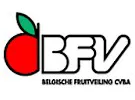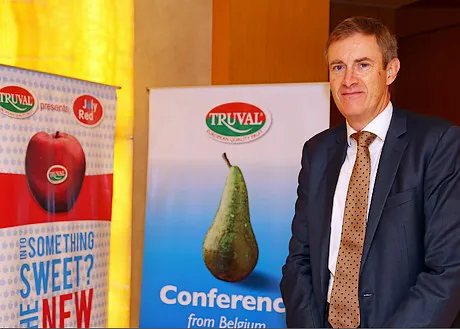 He came from the fruit and vegetable sector and ten years ago he started his carrier at Belgische Fruitveiling (BFV). At BFV he is known as 'the man of new markets'. This year Marc Evrard became the Commercial Director at BFV. His activities remain in the commercial sector and he speaks enthusiastically about BFV, "In recent years we have built up our expertise and we have realized that the products we grow in Belgium are very much appreciated far beyond Europe. In the beginning it took a lot of time to streamline all involved parties, but we have set up a working system."
He came from the fruit and vegetable sector and ten years ago he started his carrier at Belgische Fruitveiling (BFV). At BFV he is known as 'the man of new markets'. This year Marc Evrard became the Commercial Director at BFV. His activities remain in the commercial sector and he speaks enthusiastically about BFV, "In recent years we have built up our expertise and we have realized that the products we grow in Belgium are very much appreciated far beyond Europe. In the beginning it took a lot of time to streamline all involved parties, but we have set up a working system."
Looking for new markets
"At the time, I was brought into the commercial team to search for new markets and to negotiate with 'third' countries, countries outside the European Union. I happily worked in that position for a few years. The most successful things that happened at that time was gaining access to the Indian and Chinese markets. It took 2.5 years of negotiations to gain access to the Indian market and 3.5 years to the Chinese market. The good thing is that this was realized in a relatively short amount of time. Similar protocols for other fruits and vegetables often lasted ten years or longer before they were set in motion. The BFV was the first to officially send pears to China. For a long time getting a western pear into China was the black beast of the sector. If an organization succeeded in doing this, then it was an achievement. Later, this served as inspiration for our colleagues from other countries."
 China en India
China en IndiaExport volumes to China and India continue to rise each year, "In China's case, the volume doubles and triples annually. It costs a lot of time and money to convince the consumers in these countries that our products are of high quality and great taste. This can only be made clear through letting people taste the products. Suppose you have reached several thousand, then you're on your way to a billion in both countries. It is an ongoing process, and right now we are in the beginning stages. We have started the first step and now it is time for the hard commercial work. This means that we continue to provide a uniform and high quality product to the consumer and that we reach more and more people. There are differences in each country. For example, the retail and supermarket commercial organization is better developed in China than in India. Consumer behavior also varies per country. For example, in China consumers do their grocery shopping themselves, whereas in India this is mainly done by a housekeeper. Suppose you organize a tasting in the supermarket, in India you will not immediately reach the end consumer with the tasting and that is the challenge. We have done market research and take into account the consumers preferences of each country and the cultural taste patterns. With this in mind we have developed several varieties since 2006 with an eye on new markets in North Africa, the Middle East and the Far East. One of the varieties that continues to receive positive reviews after the taste test is the Joly Red. The Joly Red apple immediately scored in India with it's bright red color and sweet taste."
Trade moving towards reciprocity
Evrard says the BFV works through different distribution channels, "We market a part ourselves, but another part goes through exporters. If you look at the big picture, 80 to 85% of our production goes through export. Depending on the season, approximately 40-50% of the production goes to markets outside the EU. Ten years ago many of our current export destinations were nonexistent to us. Exporting to places like the Middle East, North Africa and West Africa is normal nowadays, while for years that seemed Utopian. Going forward we expect to increase the volume going to North- and South America. In terms of trade we are fortunately moving towards a reciprocity principle, whereby countries that seamlessly export products to Europe, will also be more open to imports from Europe. It would be nice if there was more openness between the different trading blocks, because this would give us more options and opportunities."
Challenges
There are certainly challenges as well in exporting to new markets, "We know that within a few weeks our apples will arrive in an Indian port in perfect shape, but locally, the transport and refrigeration is not as well organized. The Belgian apple is arriving in better condition than the apple from India itself. The production areas in India are in the north and if they want to transport the produce to the big cities it will take a few weeks. In addition, after the apples are plucked they are not always stored well and not always refrigerated during transport on poor roads. We are also seeing a preference for our products on the Indian market. Despite the fact that there are high import tariffs, 50% for apples and 30% for pears, you will find that the import market in that country yields good growth figures." Marc also notes that in terms of location, Belgium and the Netherlands have an advantage over other European producing countries like Poland, "Every Belgian and Dutch grower has very close access to one of the two largest ports in Europe. Products from other countries that leave a port, first have to travel through half a continent."
Peak
The best thing about his work is that as a team they have succeeded in various projects, "You work years and years with a group of people, in which you have to ensure that a product will be valued in an entirely new environment. If you then see that effective export has been realized, it is a really great feeling, but the best thing about that is motivating and inspiring a diverse group of people. From producers to the commercial department: you want to realize a goal together, and if you succeed, it is a reward for the entire organization, and often for the rest of the sector as well. That inspires you to keep working hard."
The future
His predecessor had more than 28 years experience at BFV. "The fact that BFV is where it is right now shows that it is a well-structured organization. Of course as an individual I can make a specific contribution, but it is important that the organization is working well. My predecessor left a nice course to follow. I will follow in his footsteps, but will keep many issues in mind at the same time. "First, our sector has evolved tremendously in recent years. 25 years ago Europe did not have open borders. In the individual member states you had to wait at the border and have customs controls carried out. Just by pushing these limits, trade has changed. Throughout these years we have evolved from a demanding market to a supplying market. We are now in a situation where supply is high and where you have to actively commercialize. An efficient way to respond to all these issues remains a challenge for the future. Of course there are many factors that you have no control over, for example the weather, the harvest in other countries and the exchange rate. Those are just a few things, but they can have an enormous impact on trade. There is actually quite little that you can predict."
Challenges
He continues: "What we do know is that it is getting more interesting. Trade and production are both agile and dynamic. A lot changes, but the changes also create new opportunities. It is up to us to respond as best as possible. Of course not everything will be successful, but we will continue to invest and think ahead. Because we searched for new markets and products many years ago, dealing with the crisis of the Russian boycott was slightly less difficult for us." In terms of new products the world is not standing still and that is also a challenge for us. "We are seeing more and more varieties and species of fruit. These are our competitors, and not only with similar products like apples and pears. Another challenge is the increasing proportion of migrants. In terms of consumption, migrants bring change. How will we deal with that?"
Professionalization
BFV represents 50% of the total top fruit production in Belgium. "We continue to invest in new products and in quality. Success stories from these investments include Joly Red, Redlove and the Belgica apple. In addition, since 2013 we have been focusing extra on Jonagold, the Jonaplus. Of course we don't want to be the ones always reinventing things, but high quality products bring you to the end consumer in a recognizable way. Recognition is an important pillar here." He emphasizes that they are constantly looking for new innovations in the area of quality, products and markets. "The process of searching for the best product for a new market keeps coming back and we are forced to repeatedly question everything. From the field to the plate, or from the the grower to the consumer, we need to know everything. This certainly helps professionalize our company and the sector."
Voor meer informatie:
Marc EvrardBelgische FruitveilingMontenakenweg 82
3800 Sint-Truiden - België
+32 11 69 34 11
www.bfvBF.be He came from the fruit and vegetable sector and ten years ago he started his carrier at Belgische Fruitveiling (BFV). At BFV he is known as 'the man of new markets'. This year Marc Evrard became the Commercial Director at BFV. His activities remain in the commercial sector and he speaks enthusiastically about BFV, "In recent years we have built up our expertise and we have realized that the products we grow in Belgium are very much appreciated far beyond Europe. In the beginning it took a lot of time to streamline all involved parties, but we have set up a working system."
He came from the fruit and vegetable sector and ten years ago he started his carrier at Belgische Fruitveiling (BFV). At BFV he is known as 'the man of new markets'. This year Marc Evrard became the Commercial Director at BFV. His activities remain in the commercial sector and he speaks enthusiastically about BFV, "In recent years we have built up our expertise and we have realized that the products we grow in Belgium are very much appreciated far beyond Europe. In the beginning it took a lot of time to streamline all involved parties, but we have set up a working system."
